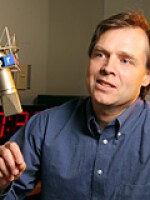MELISSA BLOCK, host:
Scientists who study the sun announced today that they're a little closer to solving some big mysteries that surround our home star. Some of these new findings may explain how the solar wind reaches speeds of more than a million miles per hour.
NPR's David Malakoff has the story.
DAVID MALAKOFF: Get on the Internet and you can actually listen to recordings of the solar wind made by a spacecraft named Galileo. The wind is actually a steady blast of atomic particles thrown off by the huge nuclear reactions that power the sun.
Mr. JONATHAN CIRTAIN (NASA physicist): When you walk outside, it just looks like a big yellow ball. But in fact, it's a very dynamic and highly evolving organism.
MALAKOFF: The sun is so dynamic, says NASA physicist Jonathan Cirtain, that one part of the solar wind, called the fast solar wind, sometimes gusts to two million miles per hour. But how it reaches those speeds has been a mystery.
Mr. CIRTAIN: The question has been how is a solar wind powered and what mechanism may be driving high rates of speed.
MALAKOFF: Now, some answers are coming from a Japanese spacecraft called Hinode or Sunrise. It's been sitting in Earth orbit for about a year now with three telescopes locked on the sun. In the current issue of the journal "Science," Jonathan Cirtain reports that he and his colleagues used one of those telescopes to spy on a potential source of the solar wind's power - giant X-ray eruptions around the sun's north pole.
Mr. CIRTAIN: One typical X-ray jet is the size of North America in width. In length, that's bigger than the Earth.
MALAKOFF: Hinode showed that these jets are more common and more powerful than anyone believed. New jets erupt on average every six minutes, and they can pack a powerful punch.
Mr. CIRTAIN: It is a huge amount of energies transferred in one brief explosion. For each of these jets, the amount of energy released is years and years if not millennia of energy production on the Earth.
MALAKOFF: But how do the jets transfer that energy to the particles in the solar wind? The answer lies in the complex magnetic field that surrounds the sun like an invisible spider web. It appears that these giant X-ray jets help jiggle that web, creating unusual magnetic pulses called Alfven waves.
Solar physicist Bart De Pontieu says the waves are named after Hannes Alfven. He was a Swedish engineer and Nobel Prize winner who predicted their existence nearly 60 years ago.
Mr. BART DE PONTIEU (Solar physicist): What Alfven waves are basically waves that shake the magnetic field of the sun. They shake the field sideways, kind of like a guitar string that has waves that when you pluck it, these are kind of the same waves.
MALAKOFF: De Pontieu works at the Lockheed Martin Solar and Astrophysics Lab in California. He says scientists couldn't easily detect these waves with older solar telescopes. Now, with Hinode's sensors, researchers can actually watch these magnetic waves ripple across the sun's atmosphere.
Mr. DE PONTIEU: I actually see the structures themselves kind of shake sideways. That was pretty exciting.
MALAKOFF: He says the waves move just a tiny fraction of the sun's enormous power. But computer models suggest that it is more than enough to give the solar wind a very big push.
David Malakoff, NPR News. Transcript provided by NPR, Copyright NPR.






